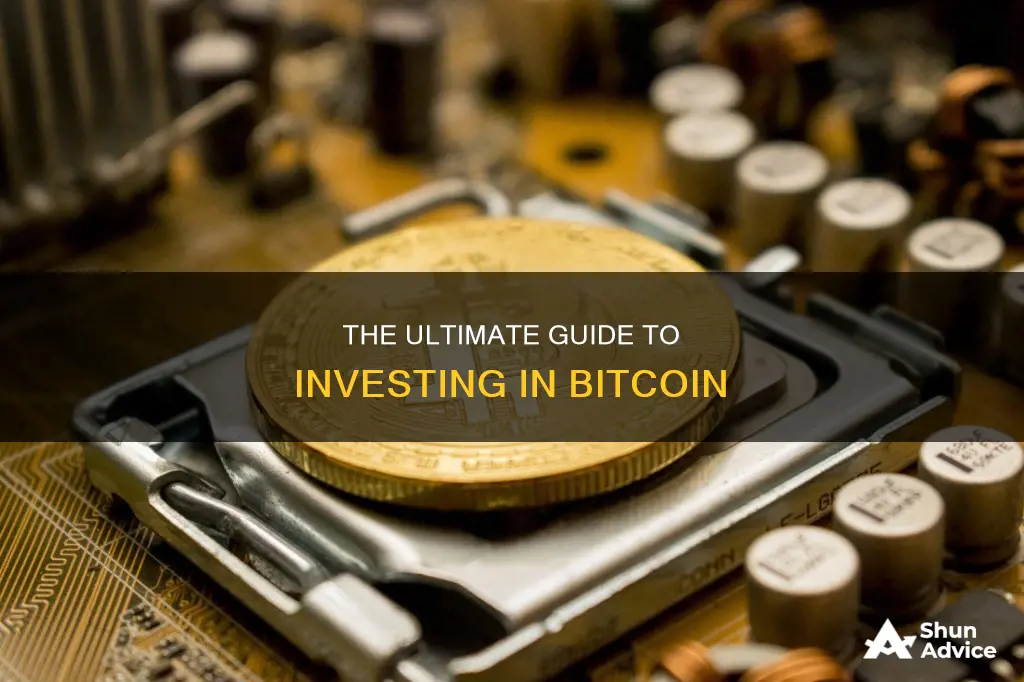
Bitcoin is a type of cryptocurrency that has become increasingly popular in recent years. It was created to solve some of the flaws in the cryptocurrency market, such as the fraudulent duplication of coins. Bitcoin uses blockchain technology, which disperses a single code over thousands of different computers, making it harder for hackers to access.
There are several ways to invest in Bitcoin, including through a company that utilises Bitcoin technology, by participating in Bitcoin mining, or by purchasing standalone Bitcoin. When investing in Bitcoin, it is important to understand your risk tolerance, diversify your portfolio, and start small.
| Characteristics | Values |
|---|---|
| How to buy Bitcoin | Via cryptocurrency exchanges, traditional stockbrokers, money transfer apps, Bitcoin ATMs, Bitcoin ETFs, or a crypto IRA provider |
| How to store Bitcoin | In a hot wallet (in the cloud) or a cold wallet (a physical device) |
| Risks | Very high-risk investment due to its volatility; vulnerable to security breaches; no regulatory infrastructure in place; no investor protection |
| Potential returns | Very high returns are possible, but these are difficult to predict and time |
| Other considerations | Bitcoin is not backed by any physical asset; there is no central regulator; the value is not linked to the profits of any one corporation; the value is dependent on market demand |
What You'll Learn

Choosing a Bitcoin exchange
- Authenticity and security: Research the exchange to ensure it is a legitimate and secure platform. Check the reputation of the platform and the security protocols they have in place to protect your data and funds.
- Payment methods: Different platforms support different payment methods for purchasing cryptocurrencies. Some common options include bank transfers, PayPal, credit cards, and debit cards. Choose an exchange that offers a payment method that suits your needs.
- Supported coins and tokens: While most crypto exchanges support Bitcoin and Ethereum, there are thousands of other cryptocurrencies. If you want to invest in coins beyond Bitcoin and Ethereum, ensure the exchange supports those coins.
- Transaction fees: The transaction fee structure varies across exchanges, so it is important to understand the fees before choosing an exchange. Look for an exchange with transparent and competitive fees.
- User interface and experience: An exchange with an intuitive interface and good user experience makes trading cryptocurrencies easier. Check the customer service and other customer-related functionalities offered by the exchange.
Some popular Bitcoin exchanges include:
- Binance: Binance is considered one of the most powerful cryptocurrency exchanges, offering access to hundreds of coins and tokens. It has a large trading volume and is available in over a hundred countries.
- Coinbase: Coinbase is a widely used digital currency exchange, particularly in the United States. It offers a user-friendly platform, strong security, and advanced trading options.
- Kraken: Kraken is one of the oldest crypto exchanges, providing trading services to thousands of users globally. It offers access to hundreds of cryptocurrencies and supports various funding methods.
- Crypto.com: Crypto.com supports over 350 cryptocurrencies and provides a range of crypto products, including its own blockchain and a native token. It also has a highly-rated mobile app.
- Gemini: Gemini stands out for its strong emphasis on security and compliance. It offers a professional-grade trading platform, insures user funds, and is SOC 2-certified.
Peter Jones' Bitcoin Loophole: A Smart Investment?
You may want to see also

Getting a Bitcoin wallet
Hosted wallets are the most popular and easy-to-set-up option. When you buy crypto using an app like Coinbase, your crypto is automatically held in a hosted wallet. It's called hosted because a third party keeps your crypto for you, similar to how a bank keeps your money in a checking or savings account. The main benefit of a hosted wallet is that if you forget your password, you won't lose your crypto. However, a drawback is that hosted wallets don't currently support all the features available in the crypto space.
Self-custody wallets, also known as non-custodial wallets, put you in complete control of your crypto. They don't rely on a third party to keep your crypto safe. While the wallet provider supplies the software, the responsibility of remembering and safeguarding your password falls entirely on you. If you lose or forget your password, there is no way to access your crypto. Additionally, if someone else discovers your private key, they will gain full access to your assets. Non-custodial wallets are a good option if you want to access more advanced crypto activities like yield farming, staking, lending, and borrowing.
Hardware wallets are physical devices, about the size of a thumb drive, that store the private keys to your crypto offline. They are considered one of the most secure methods to store funds and are ideal for storing large amounts of Bitcoin. However, they are more complex and costly than other types of wallets, often costing upwards of $100.
When choosing a Bitcoin wallet, it's important to consider what you want to do with your crypto and what level of security and convenience you need. Additionally, make sure to only download wallet apps from reputable sources, as apps can contain malware that could compromise your funds.
Gordon Ramsay's Bitcoin Adventure: Has He Invested?
You may want to see also

Connecting your wallet to a bank account
Step 1: Navigate to the "Add Account" Screen
On your dashboard, swipe left until you reach the end of your accounts. Swipe left once more, and you will see the "Add Account" screen. Alternatively, if you are on the "All Accounts" screen, click on the "Add Account" box in the list of accounts.
Step 2: Select "Connect to Bank"
Under Premium accounts, you will see the option to "Connect to bank." Click on this option to initiate the connection process.
Step 3: Search for Your Bank
In the search field, type your bank's name and country. If your bank does not appear in the drop-down list, you may need to submit a request for it to be added.
Step 4: Enter Your Login Credentials
Enter the login details you normally use to access your bank's website. Depending on your bank's security measures, you may also need to answer additional security questions or provide other authentication factors.
Step 5: Choose Your Account
If you have multiple accounts with the same bank, you will be given the option to choose which account you want to connect to your wallet. Select the desired account, and the connection process will be complete.
Mark Cuban's Crypto Portfolio: His Top Investments
You may want to see also

Placing your Bitcoin order
Choose a Cryptocurrency Exchange
Select a reputable, well-known exchange platform that offers a wide range of currencies and complies with strict regulations. Examples of popular exchanges include Coinbase, Binance, Gemini, Kraken, and Crypto.com.
Create an Account
You will need to provide personal information and verify your identity to complete the registration process. This step is crucial for security and Know Your Customer (KYC) compliance.
Fund Your Account
Before buying any crypto, you need to deposit funds into your exchange account. You can typically use fiat money, such as US dollars, or other cryptocurrencies to fund your account.
Decide on the Type of Order
There are different types of orders you can place when buying Bitcoin:
- Market Order: This is the simplest type of order, where you buy or sell Bitcoin at the best available current market price. Market orders are executed instantly and cannot be cancelled.
- Limit Order: With a limit order, you set a minimum price for the order to execute. It will only be executed at this price or higher. Limit orders give you more flexibility with the price and amount but may not be executed if the designated price is not reached.
- Stop Order: A stop order lets you specify a price, known as the stop price, at which your order should execute. If the price reaches this level, your order will trigger a sell. Stop orders help protect profits, limit losses, and initiate new positions.
- Stop-Limit Order: This is a combination of a stop order and a limit order, used to minimize risk. It involves two prices: the stop price, which triggers the order, and the limit price, which is the maximum price you are willing to pay. Stop-limit orders are not instantly executed and are useful for controlling the high volatility of Bitcoin.
Place Your Buy Order
Follow the steps required by the exchange platform to submit and complete your buy order. Specify the amount of Bitcoin you want to purchase and review all the details before placing the order.
Store Your Bitcoin in a Digital Wallet
Once your purchase is complete, you will need to store your Bitcoin in a secure digital wallet. You can choose between a hot wallet, which is typically hosted by the exchange or an independent wallet provider, or a cold wallet, which is an encrypted portable device that allows you to carry your Bitcoin offline.
Remember to do your own research, understand the risks and transaction fees associated with each exchange and order type, and only invest what you can afford to lose.
Cryptocurrency Investment: Safe or Risky Business?
You may want to see also

Managing your Bitcoin investments
- Monitor Market Trends and Regulatory News: The cryptocurrency market is highly volatile and influenced by global factors. Stay updated with the latest market trends, news, and regulatory changes to make informed decisions. Adapt your investment strategy as the market evolves.
- Choose a Reliable Trading Platform: Select a trading platform that offers a user-friendly interface, robust security measures, and a good reputation in the crypto community. Look for platforms with helpful tools to manage and track your investments.
- Diversify Your Investment Strategies: Diversification is a key aspect of managing risk. Consider adopting multiple investment strategies such as long-term holding, dollar-cost averaging, swing trading, or day trading, based on your risk tolerance and financial goals.
- Use a Digital Wallet: Set up a digital wallet to store, send, and receive Bitcoin securely. Software wallets are installed on your computer or phone, while hardware wallets are physical devices that store your Bitcoin offline.
- Practice Safe Storage: Ensure the safe storage of your Bitcoin investments. Use strong passwords, two-factor authentication, and browse the internet securely to protect your digital wallet and exchange accounts.
- Regularly Track Performance: Utilize comprehensive performance analytics tools provided by platforms like Kriptomat to track the performance of your Bitcoin holdings over time. This helps you make informed decisions and adjust your investment strategy as needed.
- Consider Dollar-Cost Averaging (DCA): DCA involves investing a fixed amount regularly, regardless of Bitcoin's price. This strategy smooths out the impact of volatility by buying more when prices are low and less when prices are high, averaging out the cost over time.
- Set Up Automated Orders: Take advantage of features like Automated Buy and Sell orders to capitalise on expected market shifts. You can also set price alerts to stay informed about market movements.
- Intelligent Portfolios: Explore platforms that offer intelligent portfolio services, where your investments are managed automatically based on data-driven investment decisions and diversified asset allocation.
- Start Small and Learn Continuously: If you're a beginner, start with small investments and gradually increase your exposure as you gain experience and confidence. Continuous learning and research are vital to successful Bitcoin investment management.
Doge Coin: Safe Investment or Risky Business?
You may want to see also
Frequently asked questions
You can buy Bitcoin through a cryptocurrency exchange, a traditional stockbroker, a money transfer app, a Bitcoin ATM, or a Bitcoin exchange-traded fund (ETF).
You can store your Bitcoin in a hot wallet or a cold wallet. A hot wallet is hosted by a cryptocurrency exchange or provider and can be accessed through the internet. A cold wallet is a physical device that you can use to download and carry your Bitcoin.
You can get started with as little as $5 or $10. Some exchanges allow you to buy fractions of a single coin, so your initial investment could be as low as $25.







